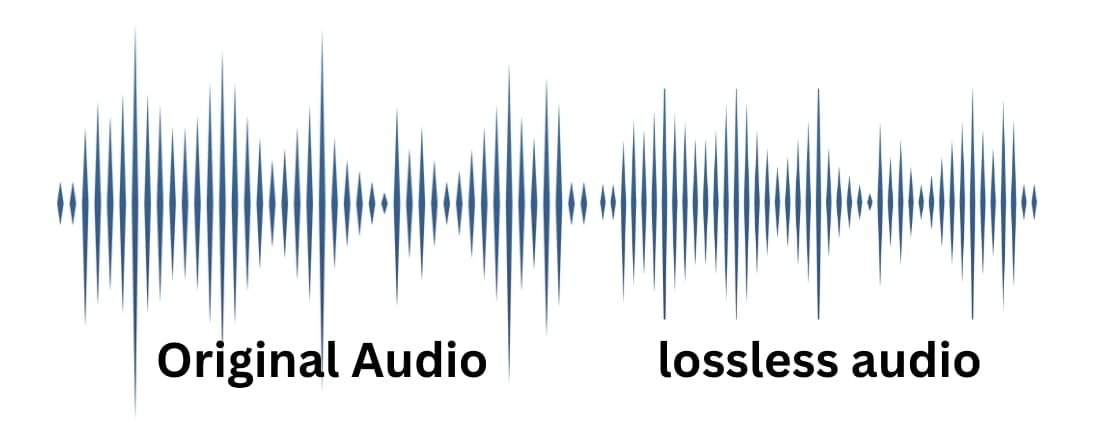This Post may contain affiliate links, when you purchase through links on our site, we may earn an affiliate commission at no extra cost to you. Here’s how it works.
For audiophiles, the quest for pristine sound often clashes with the realities of storage limitations.
Table of Contents
ToggleLossless audio formats bridge this gap, offering near-identical fidelity to the master recording while being significantly smaller than uncompressed files.
But just how big are these files? Let’s dive into the world of FLAC, ALAC, and their average sizes, shedding light on the average size of lossless audio files, and helping you make informed decisions about your beloved tunes.
What Defines Lossless Audio?
Lossless audio retains the entirety of the original audio data during compression, ensuring no loss in quality.
Unlike compressed formats, which discard some data to reduce file size, lossless formats maintain all details of the original recording.

This preservation allows for an exact reproduction of the source material when decoded, offering listeners an uncompromised audio experience that mirrors the richness and depth of the initial recording.
Factors Influencing Lossless File Size-
Several factors contribute to the size of lossless audio files.
Higher sampling rates, increased bit depths, and longer durations all contribute to larger file sizes.
For instance, audio sampled at 96 kHz or 24-bit depth will result in larger files compared to standard CD-quality audio at 44.1 kHz and 16-bit depth.
How Big are Lossless Audio Files?
Unlike their compressed counterparts like MP3s, lossless formats like FLAC (Free Lossless Audio Codec) and ALAC (Apple Lossless Audio Codec) preserve every single bit of information from the original recording.
This comes at a cost – their files are generally larger than compressed ones.
However, the size can vary depending on several factors:
Sample Rate:
This refers to the number of audio samples taken per second. Higher sample rates, like 48kHz or 96kHz, capture more detail but result in larger files. Standard CDs use 44.1kHz, a good starting point for estimating size.
Bit Depth:
This defines the precision of each sample, affecting the dynamic range of the audio. Higher bit depths, like 24-bit or 32-bit, offer richer sound but increase file size. 16-bit is common for CD-quality audio.
Number of Channels:
Stereo recordings are the most common, but multi-channel formats like 5.1 surround sound require more data, increasing file size proportionally.
Average Size of FLAC Music Files:
FLAC (Free Lossless Audio Codec) is a widely used format known for its exceptional sound quality and efficient compression.
On average, a three-minute FLAC song encoded at a standard CD quality of 16-bit/44.1 kHz might occupy around 15-25 megabytes (MB) of storage.
However, longer tracks or those recorded at higher bit depths and sample rates can substantially increase file sizes, sometimes exceeding 50-60 MB per song, but several factors can influence this:
- Sample Rate and Bit Depth: Higher sample rates (96kHz, 192kHz) and bit depths (24-bit) increase file size considerably.
- Music Genre: Complex genres like classical music tend to have larger files than simpler genres like pop or rock.
- Encoding Settings: Different encoders can slightly affect file size.
Average Size of ALAC Music Files:
ALAC (Apple Lossless Audio Codec), developed by Apple Inc., also promises lossless audio quality while maintaining compatibility with Apple devices and software.
An ALAC file of similar length and quality to a FLAC file tends to occupy a slightly larger space, averaging between 20-30 MB for a three-minute song at CD quality settings.
However, some factors can nudge its size slightly higher:
- Integration with Apple Ecosystem: ALAC files are tightly woven into the Apple ecosystem, potentially leading to metadata and artwork adding to the overall size.
- Proprietary Encoding: While both formats are lossless, the specific encoding algorithms used by ALAC could result in minor size variations.
Beyond the Numbers:
While file size is a crucial consideration, remember that the benefits of lossless audio extend far beyond mere bytes.
For discerning listeners, the uncompromised sound quality of FLAC and ALAC offers:
- Crystal-clear audio: Hear every instrument, every vocal nuance, every detail exactly as the artist intended.
- Future-proof files: Lossless files retain their pristine quality regardless of future advances in audio technology.
- Flexibility: Convert your lossless files to other formats without sacrificing quality, catering to different playback devices and needs.
The Future of File Size:
As technology advances, the battle between file size and quality continues:
- AI-Powered Compression: Machine learning algorithms are being developed to create even more efficient compression techniques, potentially shrinking lossless file sizes while preserving audio fidelity.
- Cloud-Based Solutions: Streaming services with lossless audio might become the norm, eliminating the need for local storage and allowing for on-demand access to vast music libraries.
- The Physical vs. Digital Debate: The vinyl revival shows a growing appreciation for physical formats. Will lossless audio find its way back to tangible media, offering the best of both worlds?
The Impact of Lossless on the Music Industry
The embrace of lossless audio isn’t just a personal choice; it’s shaping the future of music:
- Artist Appreciation: Lossless empowers artists to preserve their creative vision in its purest form, ensuring their work reaches listeners without compromise.
- The Hi-Res Renaissance: The demand for high-resolution music is growing, pushing studios and labels to offer more lossless options, giving music lovers a truly unfiltered experience.
The Future of Fidelity: Advances in compression and storage technology promise even smaller file sizes for lossless audio, potentially making it the standard for music consumption in the future.
Conclusion-
In conclusion, the average size of a lossless audio file is a dynamic aspect influenced by multiple factors.
While they offer unparalleled audio fidelity, their larger file sizes compared to lossy formats are a trade-off for uncompromised sound quality.
As technology advances and demands evolve, the landscape of lossless audio will continue to evolve, providing both enthusiasts and casual listeners with an array of options to experience music in its purest form.
